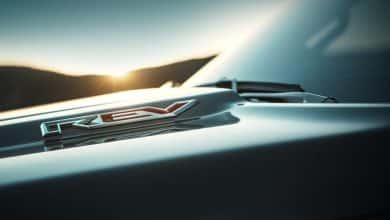GMC Acadia Review | Finding the Right Compromise

The third generation of the GMC Acadia is now 5,181 millimeters long. It has grown by 269 millimeters. This gain in size is not limited to the overall length of this vehicle capable of accommodating up to eight people on board. The Acadia is also wider and taller than its predecessor. Also heavier and, unfortunately, more fuel-efficient than before.
Why so big? The occupants of the second and third rows don't ask themselves the question. They benefit from the lengthening of the wheelbase (the distance between the two axles) as well as from the trunk, which is now larger than before. The rest has been used to increase the body's crumple zones and to give the Acadia a more intimidating presence, some will judge, on the street.
-
PHOTO PROVIDED BY GMC
The GMC Acadia
-
PHOTO PROVIDED BY GMC
The GMC Acadia interior
-
PHOTO PROVIDED BY GMC
The GMC Acadia dashboard
-
PHOTO PROVIDED BY GMC
The GMC Acadia
-
PHOTO PROVIDED BY GMC
The middle row of seats in the GMC Acadia
-
PHOTO PROVIDED BY GMC
The roof of the GMC Acadia
-
PHOTO GM-DESIGN
The GMC Acadia trunk
1/7
With increasing bulk and weight, all models that have appeared in recent years are no exception to this regrettable observation. This is a major trend: with each renewal in particular, vehicles gain in length, width and height. The Acadia is no exception, but there are other factors that have motivated its designers to make it grow and get bigger. Indeed, of the trio it forms with the Chevrolet Traverse and Buick Enclave (all these models share the same architecture), the Acadia was until now the “smallest”. In this regard, the most recent version has nothing to envy them. It is now just as imposing. So much so that the new Acadia now towers over the Yukon, the head of the GMC family.
The fact remains that the inflation of ratings contributes to fueling another drift: the increase in weight of vehicles, by around 300 kg on average over the last 20 years. A shift attributable to increased consumer demands in terms of comfort, but also to safety imperatives. So that in the case we are dealing with here, the 2024 Acadia weighs 200 kg more than the 2023 Acadia.
Faced with these excesses, engine engineers have a lot to do. And from this point of view, no one is obliged to do the impossible. The engines that once powered the Acadia have been asked to leave to make way for a “new” 2.5-liter four-cylinder turbocharged. On paper, this is more powerful than the V6 (GMC also offered a 2-liter) that was then sitting on the engine cradle and strong enough to tow a heavier load.
In theory, since much of the progress achieved has helped to absorb the lengthening and weight gain of this vehicle rather than reducing its pollutant emissions.
So, in use, this engine unfortunately proves to be more tearful under stress than the V6 and thirstier for hydrocarbons than the latter. Also, unlike the previous version, the new Acadia retains the services of an eight-speed automatic transmission instead of nine. This undoubtedly affects consumption, but this box vigilantly applies the appropriate ratio, unlike the one it replaces.
The desire to reduce engine capacity is laudable, but this unfortunate trend towards designing ever larger vehicles is becoming increasingly incompatible with the strengthening of anti-pollution standards, which require further limiting the appetite of combustion engines.
Some will be surprised that GMC did not take advantage of the renewal of this model to introduce a hybrid engine.
Especially after Mary Barra, President and CEO of General Motors, confirmed that she would delay some investments in all-electric and give more space to hybrid within the group's brands. This announcement came last spring, so much too late to change the specifications of this vehicle. For now, everything indicates that this two-headed mechanics is not in the plans for this model.
The architecture on which the Acadia is based is called C1-2. It is an evolution of the previous one which, in Canada, is grafted exclusively to a four-wheel drive mode. The latter, with temporary grip, has an active torque vector attached to the rear differential to improve traction on soft terrain. This system is only offered on the AT4 version. This one also has the singularity of fitting 18-inch tires and sheltering its vital organs behind protective plates.
All versions of the Acadia (Elevation, Denali and AT4) are on an equal footing in the area of electronic aids and other safety features. And for the first time, all offer semi-autonomous driving (SuperCruise). And it may be better to use this feature, given the Acadia's steering feedback is weak. Setting it to Sport mode doesn't change anything, except to make it heavier. The Acadia doesn't provide much driving pleasure, but that's not its main objective. This utility vehicle is more concerned with making its occupants travel comfortably—the suspension responds correctly to imperfections—and nothing more.
A new era
The Acadia is a vehicle to be experienced from the inside out. GMC has extensively reworked the cabin, whose presentation makes a (further) leap in quality with precise fittings and a variety of materials. In the center of the dashboard is a large vertical multifunction screen that allows you to see the outside world from all angles (up to eight cameras) to make driving easier. Not everything is perfect. The gear selector is not the most intuitive and too many controls have been relocated to the large window, which represents sources of distraction.
Good news for the rear passengers, however: they no longer have to sit with their legs almost vertical. Better still, the occupants of the third row no longer have to watch the landscape pass by through a loophole. For them, the Acadia now has a sense of travel.
Visit the GMC Canada website
GMC Acadia
- Price range: $55,333 to $67,333
- Consumption: 11.2 L/100 km
- CO emissions2 : 262 g/km
WE love
- Interior volume
- Neat interior presentation
- Semi-autonomous driving (SuperCruise) available across the range
We like less
- Apathetic management
- Underpowered
- Disappointing consumption
Our verdict
Share your experience
The Press will soon be publishing reviews of the following vehicles: Chevrolet Blazer EV, Mini Cooper, Nissan Kicks, and Toyota Camry. If you own one of these vehicles or are waiting for one to be delivered, we would love to hear from you.
Write to us to tell us about your experience


















